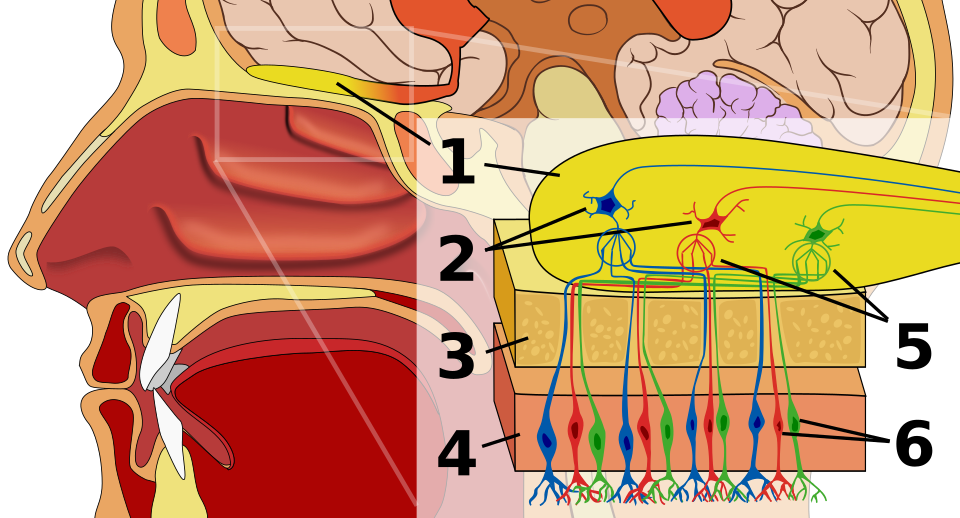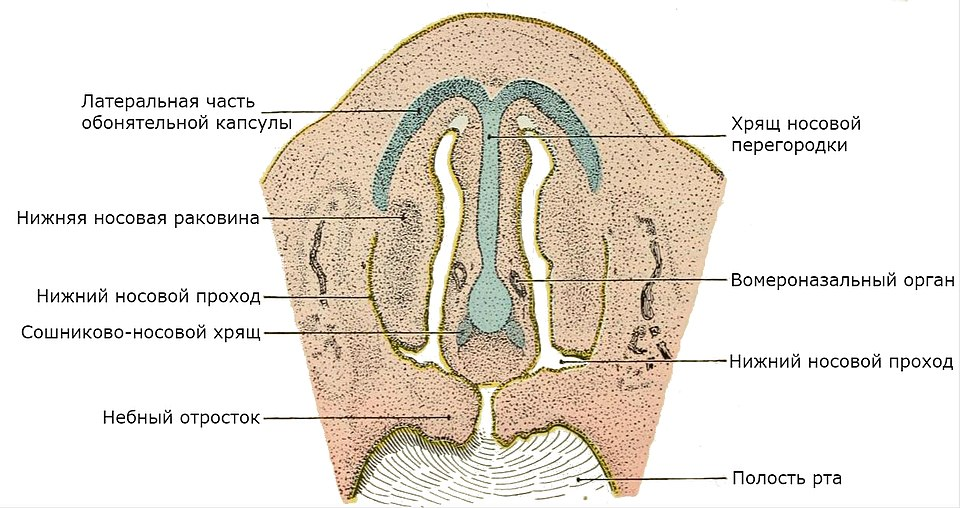IB Syllabus focus:
'- Evidence for human pheromones
- Role in attraction and social cues
- Current debates and research'
Pheromones are chemicals believed to act as messengers between individuals, conveying information such as reproductive status. In humans, the study of pheromones is a field marked by debate and ongoing research.

Diagram of the human olfactory pathway, including olfactory epithelium, glomeruli, mitral cells, and the olfactory bulb. While humans lack a clearly functional accessory (VNO–AOB) system, this figure contextualizes how odor information is processed in the primary olfactory system; some labels exceed the syllabus but aid understanding. Source.
Evidence for Human Pheromones
The existence of human pheromones is a contested subject in scientific communities, with various studies presenting evidence both for and against their presence and influence.
Research Studies and Findings
VNO Studies: Some studies have focused on the Vomeronasal Organ (VNO), believed to detect pheromones in many animals. While a VNO has been identified in human fetuses, its functionality in adults remains disputed, with many researchers asserting its atrophy post-birth.

Frontal section of a human embryo’s nasal cavity with the vomeronasal organ labeled (right), illustrating the structure’s prenatal presence. This supports debates about vestigiality and limited function in adult humans. Source.
Sweat Studies: Research involving sweat samples has been pivotal. For example, a study demonstrated that women’s menstrual cycles synchronised when exposed to sweat from other women, suggesting a pheromonal interaction. However, criticisms surround the lack of identification of specific chemical compounds responsible.
Androstadienone Studies: Androstadienone, a compound found in male sweat, is purported to affect women’s mood and cortisol levels. This compound is often studied as a potential human pheromone; however, conclusive evidence remains elusive. The study of oxytocin may also offer parallel insights into how chemical signals influence human behaviour.

Structural formula of androstadienone, a 16-androstene steroid often investigated as a putative human pheromone. The diagram identifies double bonds and the 3-one functional group referenced in research on mood and endocrine responses. Source.
Role in Attraction and Social Cues
The hypothesis that human pheromones play a role in attraction and convey social cues is grounded in the extensive evidence from the animal kingdom.
Sexual Attraction
Symmetry and Attraction: Studies have correlated body symmetry with attractiveness. It’s theorised that pheromones might convey information about an individual’s genetic symmetry and vitality. The relationship between attractiveness and genetic markers underpins the importance of exploring nature versus nurture in human attraction.
Genetic Compatibility: The notion that pheromones can signal genetic compatibility is supported by studies showing that women prefer the scent of men with dissimilar immune system genes, potentially to ensure offspring with robust immune systems.
Social Interaction
Mood Modulation: Research has explored how compounds like androstadienone can modulate mood and heighten focus and attention, possibly affecting social interactions. Similarly, the role of serotonin in mood and social behaviour is well documented, suggesting a complex interplay between chemical signals and human emotions.
Altered Perception: Some studies propose that human pheromones could alter perception of individuals, making them seem more or less attractive based on the conveyed pheromonal information.
Infant-Mother Bonding
There are studies indicating that newborns can distinguish between the breast odour of their own mother and that of others, suggesting a possible role of scent markers in early bonding processes. The phenomenon underscores the potential influence of chemical signals, similar to those explored in the context of neuroplasticity, on developing human connections.
Current Debates and Research
The research on human pheromones is laden with debates mainly due to the inconclusiveness and the variability in the findings of different studies.
Scientific Consensus
Lack of Identified Pheromones: One of the central points of contention is the absence of any chemically identified and universally accepted human pheromones. The scientific community usually requires chemical identification and behavioural testing to establish a substance as a pheromone.
Methodological Critiques: Many studies on human pheromones face criticism for their methodologies. The lack of standardisation in methods and the absence of double-blind controls in some studies have raised questions regarding the validity of their findings.
Evolutionary Perspective
Loss of Function: Some scientists argue, from an evolutionary standpoint, that humans may have lost functional pheromone communication due to the development of complex social structures and reliance on visual and auditory cues.
Relevance of Animal Models: The relevance of animal studies to humans is another debated aspect. While pheromones are well-documented in the animal kingdom, extrapolating these findings to humans is considered problematic due to fundamental anatomical, physiological, and behavioural differences.
Pheromone Products
Marketisation and Skepticism: The market is flooded with products claiming to contain “human pheromones” that can enhance attractiveness and social appeal. The scientific community largely views these claims with skepticism due to the lack of empirical support and established pheromonal compounds in humans.
Ongoing Research and Developments
Advanced Technologies: Advances in analytical chemistry and neuroimaging are paving the way for more rigorous and nuanced exploration of potential human pheromones. These technologies could help in identifying specific compounds and elucidating their effects on human behaviour.
Multidisciplinary Approach: The incorporation of genetics, psychology, neuroscience, and other disciplines is providing a more holistic understanding of human interactions and attractions, potentially unraveling the enigma of human pheromones.
Conclusion
The existence and impact of human pheromones remain in the realm of scientific uncertainty. While there is intriguing evidence suggesting their role in attraction, social interaction, and mood modulation, the absence of identified pheromonal compounds and conclusive findings keep the discussions and investigations alive. Advances in scientific methodologies and multidisciplinary approaches continue to probe the complexities of human chemistry and interactions, seeking to demystify the latent communicative potentials hidden within our biological makeup.
FAQ
Cultural norms, societal values, and individual variances play a significant role in determining how potential human pheromones are received and perceived. Cultures have different attitudes towards natural body odours and their management, influencing the acceptance and awareness of inherent scents and, consequently, the reception of potential pheromonal signals. Additionally, individual genetic variations can impact the sensitivity and receptivity to different scents, introducing a level of subjectivity in the perception of pheromones. Acknowledging and analysing these diverse factors are essential in studying human pheromones as they contribute to the multifaceted nature of human pheromonal communication.
Indeed, the efficacy and perceptibility of potential human pheromones can be significantly influenced by perfumes and body odours. The use of perfumes and deodorants can mask natural scents, possibly altering or suppressing the inherent pheromonal cues and impacting interpersonal attractions and interactions. Additionally, the presence of strong body odours may interfere with the subtle nature of pheromones, hindering their detection and influence. Understanding these interactions and influences is pivotal in pheromone research as it can offer insights into the modulation and variability of pheromonal effects in real-world scenarios.
Conducting research on human pheromones necessitates stringent ethical considerations, particularly focusing on informed consent, participant welfare, and data privacy. Participants must be adequately informed about the study's objectives, methodologies, and any potential risks or discomforts, ensuring their voluntary participation with a clear understanding of the research context. Maintaining the anonymity and confidentiality of the participants is crucial to protect their privacy and dignity, especially considering the intimate nature of studying body scents and attractions. Researchers must uphold the highest standards of professionalism and ethical conduct to navigate the sensitive aspects of pheromone research and ensure the integrity and credibility of their studies.
Studies on animal pheromones are integral for our comprehension of human pheromones as they establish a foundational understanding of pheromonal communication in the animal kingdom. Many animals utilize pheromones for various purposes, including communication, mate attraction, and territory demarcation, providing a rich source of information and comparative analysis. By observing and analysing the explicit and diverse ways animals use pheromones, scientists can formulate hypotheses and design experiments to investigate the existence, nature, and function of pheromones in humans, thereby enhancing our understanding of potential similarities and differences between species.
Studying human pheromones is of immense significance as it provides insights into the mechanisms of subconscious communication and attraction between individuals. From an evolutionary standpoint, understanding pheromones is crucial as it can elucidate the intrinsic methods our ancestors might have used for mate selection, focusing on compatibility and ensuring the propagation of robust genetic traits. This study also aids in exploring how evolutionary adaptations have shaped human behaviours, attractions, and interactions in the contemporary era, offering a deeper understanding of the intrinsic biological processes that underlie human relationships and social dynamics.
Practice Questions
The evidence for human pheromones is contentious, with studies offering contrasting conclusions. Research has explored the Vomeronasal Organ’s (VNO) role in detecting pheromones, but its functionality in adult humans remains unproven. Studies on compounds like androstadienone, found in male sweat, have indicated potential effects on mood and cortisol levels in women but lack consensus on their pheromonal properties. Furthermore, experiments demonstrating menstrual synchrony in women exposed to each other’s sweat suggest pheromonal interaction, but the absence of identified specific compounds hinders conclusive interpretations.
Potential human pheromones are theorised to play significant roles in attraction and social interactions. The scent of individuals, possibly carrying pheromonal information, is hypothesised to signal genetic compatibility and body symmetry, both correlated with attractiveness. For instance, women reportedly prefer the scent of men with dissimilar immune system genes. Additionally, compounds like androstadienone are speculated to modulate mood and perceptions during social interactions, potentially altering perceived attractiveness. However, the lack of conclusive evidence and identified human pheromones leaves these theories largely in the realm of speculation.

